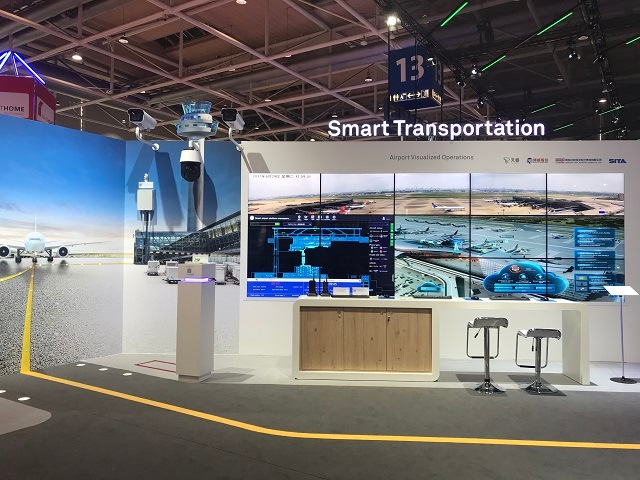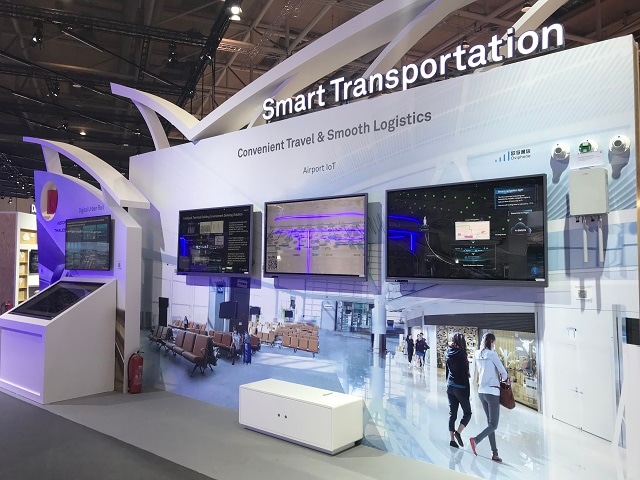Huawei Launches Smart Airport 2.0 Solution at CEBIT 2018
[Hannover, Germany, June 12, 2018] At CEBIT 2018, Huawei proudly launched its Smart Airport 2.0 Solution that covers a wide range of aspects such as visualized operational processes, visualized safety, visualized services, and airport IoT. The solution provides global airports with an innovative one-stop ICT platform featuring cloud-pipe-device collaboration, helping customers build future-oriented smart airports.

Huawei Smart Airport Visualized Operations Booth
Compared with the visualized ground handling solution of Smart Airport 1.0, the new Smart Airport 2.0 Solution focuses more on technology linkages among intelligent video surveillance, Big Data and Artificial Intelligence (AI), and the Internet of Things (IoT). This enables data interaction among various vertical business systems at airports, drives intelligent and efficient airport operations, accelerates security responses, and delivers more convenient and comfortable passenger experiences.
In recent years, the booming global civil aviation industry has witnessed continuous and rapid increases in passenger traffic and airline revenue. According to the latest statistics of the International Air Transport Association (IATA), global demand for air travel is expected to grow by 7.0% in 2018, and the total number of air passengers is expected to soar to 4.36 billion. In 2018, the net profit of global airlines will reach approximately US$33.8 billion, and global air travel expenditures will increase by 10.4% to US$794 billion. Civil aviation has become one of the fastest-growing industries in the world.
Authoritative reports show that global airport ICT investments are mostly influenced by upgrading passenger service items, travel safety, mobile commerce, and new technologies. Driven by these factors, airports are undergoing digital transformation toward smart operations and development. As for service capabilities and ICT environments, airports pay greater attention to business continuity, reliability, and stability. To achieve this, powerful ICT infrastructures and creative solutions are urgently needed.
However, with mounting operational pressures, airports now face multiple challenges such as complex safety issues, limited operational resources, and low passenger satisfaction. Consequently, the contradiction between the rapid growth of air transportation volume and insufficient operational support capabilities is prominent. The service process lacks timely and accurate operating status and assurance resource monitoring, which reduces the efficiency of communications, production command, and dispatch.
In addition, airports are densely populated, but currently their visualized safety management and control measures are complex and ineffective. Airport-wide sensing, analysis, and response capabilities need to be enhanced as soon as possible.
Passenger experience is another top priority for airports. To build a smart airport, continuous efforts must be made to provide an E2E, convenient, and pleasant travel experience for passengers from the moment they arrive at the airport, to passenger check-in, baggage drop, security check, waiting, transfer, and baggage claim.
The newly released Huawei Smart Airport 2.0 Solution uses new ICT technologies such as digital collaboration, cloud computing, IoT, and Big Data to reconstruct airport information flows. It brings remarkable benefits to smart airports in terms of operational safety assurance, mobility, operating efficiency, and the quality of services for passengers and enterprises. From the perspectives of terminal building safety, apron operation, and passenger experience, the Smart Airport 2.0 Solution provides all-scenario designs that run through every step of an airport’s aircraft flow and passenger flow. The solution also delivers an optimal passenger experience through airport-wide situational awareness, advanced security functions, and intelligent collaboration.

Huawei Smart Airport IoT Booth
Visualized Operational Processes: Improving Airport Efficiency and Visibility
The operating efficiency of an airport is critical to its own profits and service levels. Huawei’s Smart Airport 2.0 Solution helps airports implement the smart allocation of aircraft stands, smart navigation lighting, and visualized ground handling, which improve operating efficiency and reduce flight turnaround time.
Taking the allocation of intelligent aircrafts as an example, the airport could allocate thanks to the use of big data and artificial intelligence, which will increase the utilization of the corridors and bridges, and 10% increase in the passengers' rate on the bridge will help passengers save 2,300 hours per day.
The IoT-based smart navigation solution is able to monitor and control navigation lights in real time, which has been a long-time issue for the aviation industry, reducing manual inspection costs by more than 10,000 hours per person per year. Lighting navigation improves the efficiency and safety of aircraft on runways and taxiways. In addition, the visualized ground handling solution, based on LTE technologies and Huawei’s Integrated Communication Platform (ICP), enables long-distance wireless coverage up to 3 km, allows one network and one terminal device to carry voice, data, and video services in a unified manner, and monitors ground vehicles in real time with the full visibility of speed and location, which ensures visualization of the whole flight support process, and minimizes and controls risks.
Visualized Safety: Making Airports More Precise and Intelligent
Huawei’s Smart Airport 2.0 Solution provides airports with tailor-made panoramic video surveillance and intelligent perimeter protection to ensure airport safety. Using 4K intelligent cameras, as well as passive optical networks for quick video backhaul, Airport Operations Center (AOC) personnel can easily monitor the whole process of takeoff and landing, and automatically track flights, achieving ultra-HD surveillance without any blind spots. Based on linkages between the IoT and intelligent video surveillance, sensor-triggered alarms are automatically analyzed by the intelligent video surveillance system to screen invalid information, reducing the false alarm rate from 99% to less than 10%. This marks the transformation from technical protection to intelligent protection.
Visualized Services: E2E Convenience and High Quality for Passengers
Huawei’s Smart Airport Visualized Services Solution leverages technologies such as the IoT, Big Data analytics, and biometric recognition, helping airports deliver an optimal experience for passengers.
Based on facial recognition technology of the intelligent video surveillance system, passengers can quickly go all the way from security check to boarding. By simply presenting their faces, passenger flight information and boarding gate navigation maps are automatically shown on the flight information display screens.
With the introduction of IoT technologies, passengers can view baggage status and location in real time from drop-off, transport, and claim — preventing baggage loss. Wi-Fi-based indoor positioning technologies are used to help airport operators quickly collect passenger traffic statistics and adjust the operation hours of security check channels in real time, reducing passenger wait times.
“Huawei provides airports with an end-to-end ICT solution with a competitive edge at the cloud, pipe, and device layers,” said Liu Zhongheng, President of the Transportation Sector of Huawei Enterprise Business Group. “The solution improves ICT-based, intelligent, and secure airport management and enhances passenger experiences. This is the value of Huawei’s collaboration with customers and partners in the construction of fully connected, intelligent, and passenger-friendly smart airports. In the future, Huawei will continue innovating and focus on developing ICT solutions that use cloud computing, mobile connectivity, IoT, and Big Data, helping customers achieve digital transformation and build future-oriented smart airports.”
Huawei is committed to becoming the preferred digital transformation partner of aviation industry customers. Huawei has provided ICT products, solutions, and services for more than 50 airports, airlines, and air traffic control authorities, including 15 global airports with more than 30 million annual passengers. Huawei wishes to enhance mutual trust and create mutual benefits with airports, aviation industry customers, and partners to reshape the future through innovation.
Huawei, together with its partners and customers, is showcasing new digital transformation solutions to orchestrate a digital symphony at CEBIT from June 11-15 in Germany, the home of classical music. It is also hosting activities and sharing best practices around Cloud Computing, Artificial Intelligence (AI), Big Data, Internet of Things (IoT) and Software-Defined Networking (SDN), all of which play a critical role in today’s digital transformation.
Huawei’s booth is at Area C01 in Hall 13, Hannover Exhibition Center, Germany. For more information about Huawei at CEBIT, please visit http://e.huawei.com/topic/cebit2018-en/index.html. To learn more about Huawei’s worldwide customer cases using "Leading New ICT", please visit http://e.huawei.com/topic/leading-new-ict-en/index.html.

